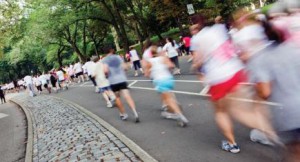Breaking Down 5 Common Running Injuries
 Runners are a hearty bunch, but they are also prone to a variety of overuse, muscle, and joint injuries. Improper body alignment and movement inefficiencies can cause injuries to the hips, knees, and feet. Physical therapists and sports performance specialists help runners avoid or reduce their risk of injury by teaching them how to correct their form on the road.
Runners are a hearty bunch, but they are also prone to a variety of overuse, muscle, and joint injuries. Improper body alignment and movement inefficiencies can cause injuries to the hips, knees, and feet. Physical therapists and sports performance specialists help runners avoid or reduce their risk of injury by teaching them how to correct their form on the road.
Some of the common injuries our physical therapists see include:
- Female Hip Pain
Women are more likely to experience hip pain due to the wider set of their hips. By speaking to a physical therapist about hip pain, female athletes can learn about proper techniques to help restore hip alignment and control and reduce the risk of iliotibial band syndrome (pain outside the knee). - Runner’s Knee
Runner’s knee results from over-striding, when a runner’s foot lands too far from the body and displaces weight awkwardly over the knee. Sports performance specialists can evaluable a runner’s stride and teach them how to adjust their stride to lessen stress on the knees. - Age-Related Conditions
Knees are the most injured site for runners and comprise about 20% of all running injuries. But, for runners over 40 years of age, the Achilles tendon and calf are more vulnerable to injury and should be strengthened and monitored for weakness or pain. - Foot Injury
Achilles tendonitis and plantar fasciitis are among the most common foot injuries for runners. While wearing the correct shoes and the use of custom orthotics can help assuage discomfort, many athletes suffering from foot pain can benefit from foot and ankle therapy programs designed to rehabilitate past injuries and prevent future ones. - Stress Fractures
Most common in runners under 30, these injuries are thought to be connected to forceful stride patterns. Runners who ran “softly” reduced the force on their legs and thereby lessened their likelihood of a stress fracture.
If you’re a runner struggling with nagging pains, like those described above, you may want to consider visiting a physical therapist or a running specialist for an evaluation of your functional movement and mobility. These experts can help you recover from injury, get back in the race, and prevent future issues.

